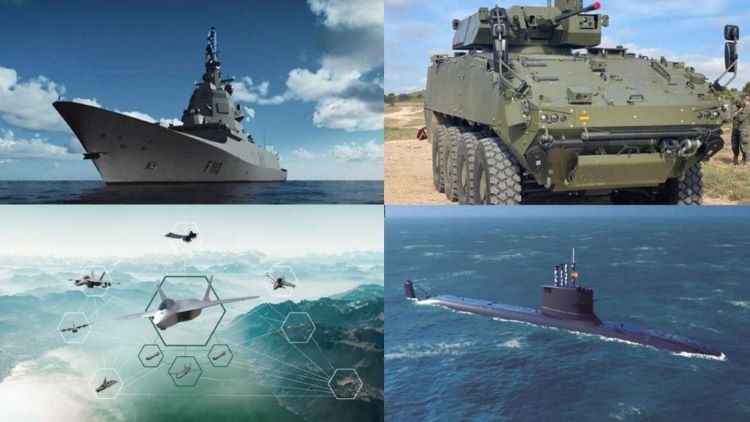Oscar Ruiz –Escudo Digital
The Minister of Defense, Margarita Robles, appeared on March 22 for the first time in this legislature before the Senate Defense Commission to present the general lines of her Department’s policy, and highlight the role that Spain increasingly assumes in international missions to contribute to peace and security.
In this appearance, the Minister of Defense presented her vision of the defense environment along with the announcement of a defense spending forecast of 1.30% of GDP by 2024. She detailed Spain’s military modernization efforts in this first appearance before the Defense Commission of the Senate, where he described the promotion and updating of programs that had remained “at a standstill” for too long, including the F-110 frigates, the S-80 submarine or the 8×8 combat vehicle programs, and European projects such as the Future Air Combat System (FCAS).
“Above all, we have approved an Industrial Defense Strategy, which did not exist, in the same line as other European countries,” said Robles, adding that the investment in Defense aims to “increase the level of strategic autonomy and contribute to the European of Defense”, consolidating an industrial and technological base of the Armed Forces.
Spain’s defense budget currently amounts to 1.24% of its GDP, although with the imminent intention to raise it to 1.30% in 2024.
At this moment, the major projects of our defense industry are:
F-110 frigates
On December 16, 2023, Navantia cut steel for the first time for Spain’s second F-110 class frigate, the F-112. The first cut has been made four months ahead of schedule, showing that the program, valued at €4.33m ($4.65m), has been accelerated, which has also seen an advance in the work of the first frigate, the F-111, under construction since 2022, and which would have completed 24 of 33 blocks by December 2024, of the 18 that were originally scheduled for completion.
The F-110 frigates of the Spanish Navy are multipurpose escort ships, with anti-aircraft, anti-surface and anti-submarine capabilities that will allow them to perform their force protection and naval projection functions. These ships, which are intended to operate in combination with other units, make them versatile platforms that can perform functions related to maritime security.
Submarine S-80
In October 2023, Spain saw the S-80 Isaac Peral submarine pass its last safety checkpoint before commissioning, after sailing to maximum operational depth.
The S-80 was first planned in 1989 and ordered for production in 2003, although we all know the problems of the S-80 program, which has had a difficult road to delivery, suffering from overweight problems that necessitated the involvement of General Dynamics in the design process in 2013. Extensive redesigns in the 2010s and a Spanish government budget crisis led to significant delays.
The Isaac Peral was initially expected to enter service in 2015, followed by the Narciso Monturiol in 2016, and two more submarines of its class; the Cosme García in 2018 and Mateo García de los Reyes in 2019 respectively. Delivery dates have been updated and operational use is expected in 2024, 2026 and 2028, respectively. The cost of the submarines has risen to €977m ($1bn) per submarine.
8×8 Dragon Combat Vehicle
The Dragon vehicle is primarily based on the GDELS Piranha 5 8×8 wheeled combat vehicle.
A program to develop a new armored vehicle capability was launched in 2007. Seven companies were selected and then narrowed down to three potential competitors after the first phase of the selection process. The competitors were the Boxer from Krauss-Maffei-Wegmann, the VBCI from Nexter and the Freccia from an Italian consortium. However, the program was canceled in 2010 due to budget cuts.
In 2013 it was reactivated, but without recovering any of the previous competitors. Instead, TESS Defense SA, a consortium of General Dynamics-Santa Bárbara Sistemas, Escribano, Indra and Sapa, received a contract to develop an armored vehicle based on the Piranha 5.
In August 2020, the Spanish Ministry of Defense awarded a €1.74 billion ($2.06 billion) contract to the General Dynamics European Land Systems-Santa Bárbara Sistemas (GDELS-SBS) joint venture in August 2020 to produce 348 8×8 Dragon VCR wheeled combat vehicles. There is also the option to extend the acquisition program to include a total of 1,000 vehicles. The first production-grade units of the Dragon were ready for testing in August 2022.
In January 2024, Robles met with the Secretary of State for Defense, Amparo Valcarce, and the CEOs of TESS Defense SA, to “convey his great concern about the lack of progress and the level of compliance with the 8× vehicle program 8”.
FCAS
Spain joined the FCAS program in June 2019, as the third member of the project, along with France and Germany. The FCAS is intended to include next generation fighter jets (NGF) and unmanned systems such as remote drones (RCs) that will fly alongside manned fighter jets and cruise missiles.
All manned and unmanned elements will be connected by a combat cloud that will be supported and directed by artificial intelligence. The air forces will be able to operate the FCAS sixth-generation aircraft at a safe distance while deploying the remote aircraft in dangerous areas to deal with emerging threats.
Key capabilities of the aircraft include enhanced survivability with active and passive stealth features, enhanced situational awareness through advanced avionics, and a comprehensive and impressive sensor suite. This combat aircraft will also provide greater maneuverability, speed and range, thanks to a powerful engine and a highly advanced flight control system.






